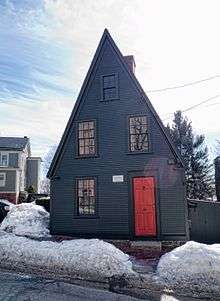Lightning splitter

A lightning splitter is an architectural design referring to wood-framed homes with sharply angled multi-story gable roof. The sharply angled gable was believed in local Rhode Island folklore to split or deflect bolts of lightning. Architectural evidence suggests that new constructions and modification of existing homes to the style were predominantly in the mid-19th century. By 1980, the number of surviving lightning splitter homes was believed to be about half a dozen.
Background and design
Lightning splitters are named from the folklore or superstitious belief that the sharp angle of the gable will deflect or split lightning. The unique style arose in and around Providence, Rhode Island with the greatest prominence in constructions or modifications occurring in the mid-19th century.[1]
In 1907, George H. Hubbard wrote an article in New England Magazine that connected one early lightning-splitter with a notorious counterfeiting gang. Contained within his detailed account of Abel Starkey's capture was a home owned by that had a single story and three successive stories of attics through an extraordinarily high and steep roof. According to Hubbard, the house was the refuge of the counterfeiters for a number of years. The couple who owned the house was not suspicious, but the counterfeiters were eventually tracked to the location and a thorough investigation was done by the authorities. After a time the public and authorities continued to track members of the gang to the location and investigations were performed only to turn up empty. Sheriff Johnson of Worcester tracked the counterfeiters to the house one day and set up a team of men outside and inside the house to uncover and arrest the counterfeiters. A careful search turned up nothing, so measurements of the house were taken to make sure no secret rooms or areas existed. With the inaccessible third attic all but ruled out, the discovery of its access through the chimney was by chance. Given the dating of events this house was built prior to 1825 and had been carefully modified to conceal the counterfeiting operation.[2]
Surviving examples
- The Bicknell-Armington Lightning Splitter House is the only example that is listed on the National Register of Historic Places. Constructed around 1827 and heavily modified around 1850, this house is named for the first two owners of the property.[1][3]
- The Daniel Pearce (c1755 - 1800) House at 53 Transit Street in Providence[4] is another historic example. Constructed about 1781[4] and modified to the lightning splitter style circa 1860, the home exhibits a narrower and sharper angle than the Bicknell-Armington House.[5]
References
- 1 2 "Historic Resources of East Providence, Rhode Island (PDF page 38)" (PDF). Rhode Island Preservation. Retrieved 2014-09-06.
- ↑ Hubbard, George (1907). "Legends of Old Newgate". New England Magazine. Retrieved 17 July 2015.
- ↑ "Facebook - City of East Providence Historic District Commission's Photos". City of East Providence Historic District Commission. 12 April 2015. Retrieved 16 July 2015.
- 1 2 "Daniel Pearce (c1755 - 1800)". Gaspee Virtual Archives. The Gaspee Days Committee. Retrieved 4 December 2016.
Daniel Pearce House (c1781) still stands at 53 Transit Street in Providence, noted by its steep "lightning splitter" roof.
- ↑ Raven, Rory (2008). Haunted Providence: Strange Tales from the Smallest State. The History Press. pp. 32–33.
